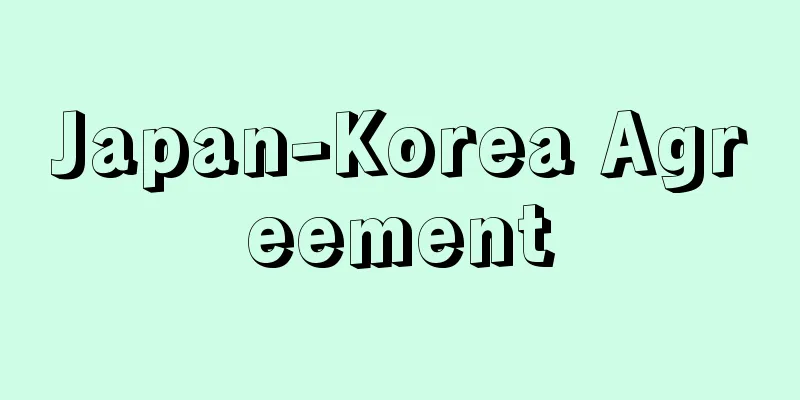Japan-Korea Agreement

|
After the outbreak of the Russo-Japanese War, Japan concluded three treaties with the aim of making Korea a protectorate. (1) The First Japan-Korea Treaty was signed on August 22, 1904, and required the Korean government to invite one Japanese financial advisor and one foreign diplomatic advisor recommended by the Japanese government, and to consult with the Japanese government on important diplomatic matters such as the conclusion of treaties with foreign countries. (2) The Second Treaty (Eulsa Protectorate Treaty) was signed on November 17, 1905, with the consent of the great powers following Japan's victory in the Russo-Japanese War. It required the Japanese government to not only take control of Korea's diplomatic rights, but also to establish a Resident-General and to effectively control all domestic affairs of Korea. Upon learning of this treaty, Korean bureaucrats committed suicide one after another in protest, and various citizen protest movements, including store strikes, were launched, leading to the expansion of anti-Japanese volunteer militia struggles. (3) The Third Japan-Korea Treaty was signed on July 24, 1807, following the abdication of Gojong in the wake of the Hague Secret Envoy Incident. The contents of the treaty and the accompanying memorandum provided for the Resident-General to lead and control the administration and judiciary of Korea, for Japanese to be appointed to senior government posts, and for the Korean military to be disbanded. As a result, despite the increase in the Japanese military, righteous militia movements spread throughout Korea. Source: Encyclopaedia Britannica Concise Encyclopedia About Encyclopaedia Britannica Concise Encyclopedia Information |
|
日露戦争開戦後,日本が韓国を保護国化する目的で結んだ3つの協約。 (1) 第1次日韓協約は 1904年8月 22日に調印され,韓国政府に,日本政府が推薦する日本人の財務顧問,外国人の外交顧問各1名を招聘すること,および外国との条約締結など重要外交案件は日本政府と協議することとを認めさせた。 (2) 第2次協約 (乙巳保護条約) は日露戦争の勝利を背景に列強の了解を取付け,05年 11月 17日に調印したもので,その内容は日本政府が韓国の外交権を掌握するだけでなく,統監府をおいて韓国の内政全般を日本政府が事実上支配することを認めさせたものである。この協約を知った韓国官僚の自殺による抗議が相次ぎ,また商店ストをはじめとする各種の市民抗議運動が展開され,反日義兵闘争が拡大した。 (3) 第3次日韓協約はハーグ密使事件を契機に高宗を退位させ,07年7月 24日調印したもので,この協約および付属の覚え書の内容は統監が韓国の行政,司法を指導,統轄し,高級官僚に日本人を採用し,韓国軍隊を解散させるものであった。そのため日本軍の増強にもかかわらず,義兵闘争が韓国全土に広がった。
出典 ブリタニカ国際大百科事典 小項目事典ブリタニカ国際大百科事典 小項目事典について 情報 |
<<: Japan-Korea Fisheries Agreement
>>: Knickerbockers - Nikkabokkaazu (English spelling) knickerbockers
Recommend
People's Republic (MRP)
One of the centrist parties in France. It was foun...
Reduction roasting
…For example, in zinc smelting, a roasting proces...
Vereinigte Grünen Österreichs
...It has been pointed out that the growing fisca...
Meningism
…When no pathogenic bacteria can be found in the ...
Intramuros
…Although the river is only 24km long, it has a l...
Poltoratsk
…It is located 40 km from the Iranian border, in ...
Council of Councilors - Hyojoshu
In the Kamakura Shogunate, these were the members...
Shetland pony
…Many are kept as children's riding horses or...
Impromptu (French: impromptu)
A short instrumental piece, also called an improm...
Gas chromatography
Gas-solid chromatography is a type of chromatogra...
Kinji Imanishi
Anthropologist. Born in Kyoto. Graduated from the...
Götar (English spelling)
...Viking activities, which had a great influence...
Seedless fruit (seedless fruit) - tanenashikajitsu
A seedless fruit produced by parthenocarpy. Genera...
Hallyeosuido - Hallyeosuido
A waterway that runs from Hansan Island in the sou...
Lightning - Thunder
...Demon Kyogen. A quack doctor from the capital ...









![Suleiman [I] - Suleiman](/upload/images/67cbfba18998a.webp)